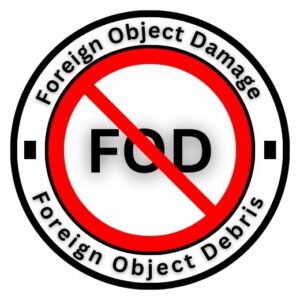
Foreign object damage (FOD) has been a frequent cause of tragic accidents and fatalities in the aviation sector for a long time. FOD cases cost an estimated RM 1.2 billion annually, a relatively high amount. Therefore, the designated organizations, including airlines, must use the appropriate approach and strategy to further eliminate FOD foreign object damage occurrences.
FOD is difficult to regulate because of several factors, including improper workplace conduct, an unfavorable work environment, inadequate technology, and an unorganized housekeeping system. The main goal of this study is to examine further and clarify FOD and the methods used to prevent it.
FOD is a widespread issue in the aviation sector and one of the factors that might lead to aircraft failure and unintended consequences, including fatalities and casualties. Many facts about FOD issues and their effects on the aviation sector are compiled and presented throughout this study.
FOD Foreign Object Damage: What Is It?
An alien substance that might harm an aircraft or system is known as FOD Foreign Object Damage. This idea applies to many parts of the ASD industry, including manufacturing, warehouses, shipping, and any location where small waste, loose objects or wildlife could pose a threat to public safety, leading to:
- Gear deterioration
- Staff members getting hurt
- Delay in manufacturing
- Violations of safety
The FOD abbreviation can refer to the phrases Foreign Object Detection, Foreign Object Damage, and other related terms.
FOD Guidelines
An organization must comply with AS9100 and have plans to identify, remove, and prevent foreign objects. Boeing uses the following documents to define a FOD program.
SAE AS9146
Aviation, space, and defense organizations must comply with the requirements of the Foreign Object Damage (FOD) Prevention Program. This standard outlines the requirements for FOD Prevention Programs for companies that create, develop, and deliver aviation, space, and defense products and services, as well as for companies that offer post-delivery support, such as maintenance (AS9110), spare parts (AS9120), or supplies for their goods and services.
NAS 412 REV. 2
To prevent foreign object damage (FOD) to aerospace goods when they are being planned, researched, produced, assembled, operated, amended, modified, reconditioned, and maintained, the military and commercial industry must adhere to the standard outlined in NAS 412 Rev. 2.
FOD and AS9100 Standard
According to AS9100 Rev D section 8 (2016), an organization must have the measures outlined in the following sections for the prevention, identification, and removal of foreign objects:
- Determining the specifications for the goods and services, such as protecting, detecting, and removing foreign objects.
- Some sections address production and service delivery control, contain provisions for removing, detecting, and preventing foreign objects.
- The organization must maintain the outputs during production and service supply to ensure compliance with requirements such as preventing, identifying, and removing foreign objects.
- The IAQG SCMH provides relevant information on foreign object damage.
For instance, leaving tools inside an airplane after it has been manufactured or serviced poses a significant risk. Tools and other objects can obstruct safe flight by tangling in control cables, jamming moving parts, shorting out electrical connections, and different ways. Before releasing an aircraft for flight, aircraft maintenance teams typically follow tight tool control procedures, including toolbox inventories, to ensure that all tools have been removed from the plane. Tools used in production are marked with serial numbers so they may be tracked down if lost.
Conclusion
Any object discovered in an improper area that, due to its presence, has the potential to damage equipment or hurt workers is considered foreign object damage (FOD) at airports.
FOD encompasses a variety of objects, such as loose hardware, paving stones, catering supplies, construction supplies, boulders, sand, carry-on bags, and even wildlife. Gates at terminals, cargo aprons, access roads, airports, and run-up pads have FOD.
